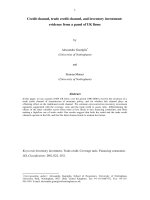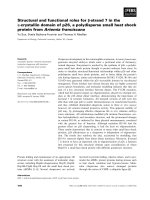Restructuring of public investment seen from aspect of systematic relation with sustainable development of public finance
Bạn đang xem bản rút gọn của tài liệu. Xem và tải ngay bản đầy đủ của tài liệu tại đây (14.99 MB, 4 trang )
Prospects
of
economic growth & development
in
2011
Restructuring of public investment in the context of innovation of development model
and economic structure is one of important tasks set for the five-year socioeconomic development plan 2011 – 2015. This paper presents three problems examined in the systematic relation between public investment and other policies within the public finance: (1)
Budget overspend and public debt; (2) Public investment and operations of finance market; and (3) Restructuring of the public sector as an instrument for dealing with negative
effects from the market. As a conclusion, the author offers suggestions about the successful and effective restructuring of public investment in future.
Keywords: public investment, budget overspend, public debt, public financial policy, finance market, stateowned companies
1. Budget overspend and public debt
A positive public financial policy must be implemented but on certain conditions.
my opinion that has been presented at the nA
many times is that vietnam has to accept budget
overspend through borrowing for years to come in
order to develop technical infrastructure and facilitate industrialization. it is a positive public financial policy when the capital accumulation and
saving are too low to ensure a sustainable development. this policy must be based on strict conditions, such as:
- A clear policy on government and national
debts must be in place.
- there must be measures to ensure efficiency
of investment projects.
- Ability to repay debts in both domestic and
foreign currencies must be ensured.
- principles of opportunity cost and consistency
of public investment must be observed.
- the government must practice thrift.
- Allocation of public investments must be
transparent.
- A mechanism for supervising public investment must be perfected.
in the past few years, however, budget overspends have not met above-mentioned requirements, among others, with the result that the
“positive public financial policy” became a negative agent that might lead to instability of public
finance.
if the public investment is implemented in
such a way, it not only increases risks for financial
system, but also contributes to macroeconomic instability (inflation and trade gap).
in the past, especially under the national As-
Economic Development Review - January 2011
27
Prospects
of
economic growth & development
sembly of 12th term, high budget overspend was
allowed to rise and more government bonds were
issued in order to ensure public investment in industries and provinces allowed by the nA. however, there is no quantitative assessment of
efficiency of these public investment projects. the
ministry of planning and investment, of course,
has its own criteria for allocating public investments but it failed to produce detailed reports on
implementation of such projects. And as a result,
all industries and provinces, after their development projects were approved, competed fiercely
for disbursement because source of public investment was limited. this practice went against list
of priorities and consistency of public investment.
this source of capital was scattered while the government had to pay interest and projects could not
be completed as planned because of slow disbursement.
this way of allocating public investments made
me think that the central government had to
cover all projects and programs after starting
them otherwise all investments become a huge
waste.
vietnam is facing a lot of difficulties. All fields
and provinces are badly in need of investment. it
is necessary, of course, to prioritize them according to certain conditions. At a national level, investment in depressed areas should aim at
political and social goals while that in regions
with favorable conditions, such as the southern
Key economic Zone, is for bigger budget income.
for example, if priority is given to rural, mountainous or border areas, development program of
national level must be carried out with support
from the central government in all stages, from
planning, implementation to evaluation of result,
instead of assigning totally to local governments.
in vocational training programs, full attention
must be paid to development of army of teachers
and employment for graduates instead of being
limited to building of schools. the same thing can
be applied to health care service.
thus, allocation of public investment cannot be
simply based on selection of industries or areas.
each project must be devised carefully to ensure
that all projects are useful after completion and
influential in local economic development. At pres-
28
Economic Development Review - January 2011
in
2011
ent, vietnam has no mechanism for determining
responsibility for ineffective public investment.
What is the safe limit for public debt?
vietnam’s public debt (according to definition
presented in public Debt management law) of
today includes mainly long-term loans, which puts
no big pressure for repayment. in 2011, it is still
safe for vietnam to allocate vnD85,000 billion for
debt repayment out of a total budget income of
vnD590,000 billion (some 15%). however, if the
after-debt income and regular expenditure keep
decreasing, the public debt may exceed its safe
limit. if budget overspend prolongs by 10 years because of increased public investment and fails to
produce higher values and surplus needed for expanded production (which reflects in difference between budget income and regular expenditure plus
debt repayment), danger of insecurity does exist.
in other words, if vietnam gets loans in 2001 to
increase public investment when no budget surplus exists, it should gain some budget surplus in
2010 after covering regular expenditure and debt
repayment. this idea forces me to suggest analyzing and assessing the public debt in the past 10
years and developing a new public financial strategy for the next 10 years to serve as a basis for
assessment of financial safety. if no prediction at
both macro and micro levels is in place, insecurity
may become insolvable when it appears. this situation is called bankruptcy.
2. Relation between public investment and operations of finance market
in the years 2001-2005, the vietnamese economy recovered in the wake of the regional financial crisis and gained an average growth rate of
7.5%. in this period, outstanding credit from the
banking system rose by 23% or 24% on average;
budget overspend was kept under 5% of the GDp;
and ratio of gross investment to the GDp was
38%.
in 2006, everything looked normal (growth
rate was 8.3%; outstanding loan rose by 24% and
the budget overspend equaled 5% of the GDp).
from 2007 onwards, however, anomalies took
place: outstanding loans rose suddenly and in the
opposite direction to the growth rate (in 2007 the
growth rate was 8.6% while the credit growth was
53.4%; these figures were 6.4% and 27.6% in 2008;
Prospects
of
economic growth & development
and 5.3% and 37.3% in 2008 respectively), budget
overspend equaled some 7% of the GDp while the
gross investment equaled 42% of the GDp.
According to my observations, causes of the situation are as follows:
Firstly, bubbles of stock and realty markets in
2006-2007 made the supply of credit skyrocket
creating a huge volume of virtual assets (gap between financial and real assets) and inflation in
those two years bridged this gap with new average
market prices. the credit growth in those years
did not lead to increases in real assets and only
produced some changes in nominal GDp. moreover, increased trade gap in the past three years
also caused the money supply to rise while the
local economy, because of a low added value in
manufactured goods, could not gain a higher
growth rate (it is estimated that from 70% to 80%
of the trade gap was transformed into export value
without making the GDp rise).
Secondly, in the years 2008-2010, the stock
market was still a secondary one and all companies had to depend on banks for their working
capital, which led to imbalance between supply of
and demand for bank credits and favorable conditions for establishment of small-scale joint stock
commercial banks and higher credit growth. this
situation made the monetary policy deviate from
its orientation and forced financial authorities to
adopt regularly ad hoc solutions, which led to serious danger of instability. Along with effects of
the global recession and financial crisis, the situation made investors lose their confidence with
the result that both loan and capital stocks could
not solve the problem while commercial banks enjoyed chances to gain super-profit. Although profits for banks increased, risks in the whole banking
system and macroeconomic instability were not
reduced and tended to change their forms instead.
Thirdly, increased and prolonged budget overspend became insolvable. poorly planned public
investment that did not observe principles of opportunity cost made the icor higher. to facilitate
the growth rate, the public investment in 20092010, including investments from national budget
and state-owned companies, rose quickly employing a huge volume of credit while budget overspend only relied on credit and increases in the
in
2011
money supply. even government bonds also depended on supports from commercial banks instead of the public. Generally speaking, both the
national budget and economic sectors were dependent on the banking system. A huge volume of
money flowed to this sector but poor investment
plans failed to produce a corresponding volume of
assets, which lowered capital turnover.
these causes could explain the credit growth
in the past three years and serious imbalance in
the finance market. the major cause, of course,
lies in the economic structure but financial and
monetary policies, and especially the fiscal policy,
have profound effects on the economic structure
and they have not been estimated exactly. thus,
the urgent task is to employ monetary and fiscal
policies to direct restructuring of the finance market; force companies in all sectors to execute financial restructuring; prevent commercial banks
from borrowing and lending too much; and make
the stock exchange a real channel of direct investment.
3. Restructuring of the public sector as an instrument for dealing with negative effects from
the market
the restructuring of the public sector should
aim at helping it play well its regulatory role and
supply better “public goods and services” needed
for a sustainable development.
from this point of view, we can see three problems with the public sector: (1) poor distinction
between companies run for profit and non-profit
public institutions (it does not mean that these institutions are unproductive but their owners refrain themselves from collecting profit; (2) poor
management that reflects in failure of state-owned
companies to ‘direct’ the market without a monopolist mechanism in spite of the fact that they are
enjoying a non-profit status (having full rights to
their after-tax profit); and (3) failure to supply
public goods and services, and develop key industries that produce low profit and require big and
long-term investment, such as engineering, supporting industries, high technologies, etc. in my
opinion, public investment must reflect political
determination of the government instead of depending on financial consideration taken by stateowned companies.
Economic Development Review - January 2011
29
Prospects
of
economic growth & development
thus, the restructuring of the public sector
must aim at turning it into a material force that
regulates effectively the market besides other regulatory instruments. this is an important feature
of the restructuring because it not only improves
the state control over economic activities but also
links economic development with social progress
and equality. A law governing the public sector is
now an urgent matter to vietnamese law makers.
in vietnam today, it is necessary to develop a
set of concepts of public finance based on ideas of
a positive public finance, and use budget overspend to built infrastructure and stimulate the economic growth. this policy, however, is a
two-edged sword that can produce bad effects
when the public management mechanism is poor.
restructuring the public investment requires
reforms in the public financial management that
has a lot to do with the administrative machinery,
allocation of public investment, mechanism for supervising and assessing business performance,
and conceptions of role and functions of stateowned companies. that is why the restructuring
of public investment should be considered against
the whole system to work out an appropriate
track. one of priorities at present is a reform in
the national Budget law that aims at distinguishing two classes of budget: national and provincial
ones. the central government establishes public
financial regulations and local governments have
autonomy in working out their own budget in-
30
Economic Development Review - January 2011
in
2011
comes and expenditures based on approval by
provincial people’s committees. the national
budget (including grants-in-aid for local governments) is determined by the national Assemble.
the overall goal is to make the annual Budget Act
according to international practice, thereby ensuring the supervision of the national budget by the
nA and local budgets by local people’s
committeesn
References
1. GSO (2010), Niên giám thống kê 2009 (Statistical
Yearbook 2009).
2. Lê Xuân Nghóa (2010), report presented at the
workshop “Macroeconomic stabilization and economic
growth” in HCMC on Sep. 21 – 22, 2010
3. MPI (2010), “Báo cáo về phân cấp đầu tư” (Report
on delegation of public investment).
4. Trần Du Lòch (2010), “Vượt qua thách thức hướng
đến mục tiêu phát triển dài hạn” (Overcoming challenges
and achieving targets of long-term development) presented at the NA 8th session in October 2010.
5. Viện nghiên cứu quản lý kinh tế trung ương (Central Institute of Economic Management Research)
(2009), “Báo cáo tái cấu trúc kinh tế” (Report on economic restructuring)
6. Vietnamese Government (2010), “Báo cáo kế
hoạch kinh tế – xã hội năm 2010 và phương hướng
nhiệm vụ năm 2011” (Report on socioeconomic development in 2010 and directions for 2011) presented at the
NA 8th session in October 2010.









